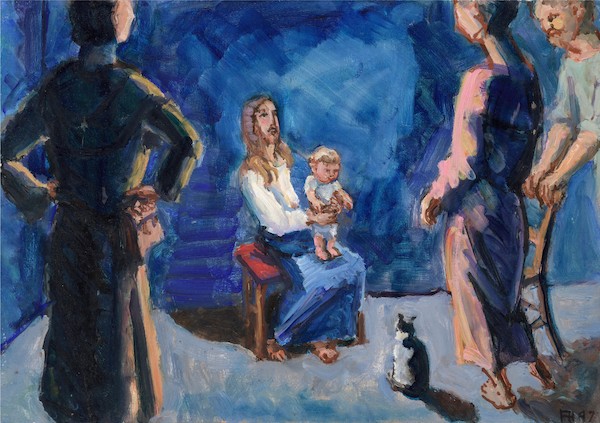“A man burning to speak”
Gert Swart was born in 1952 in Addington Children’s Hospital in Durban, in the then province of Natal, in what he describes as “a very troubled Union of South Africa.” He was raised in Malvern, Queensburgh, just outside Durban: “Queensburgh came into being in the year I was born, to commemorate the coronation of Queen Elizabeth, as we then belonged to the Commonwealth of Nations. It goes without saying that one doesn’t have much control over where or when you are born, nor the particular milieu into which you are born. I mention my specific birthplace because the hospital overlooked the Indian Ocean. I spent a large portion of my youth on the beaches opposite this hospital, whiling away my youth, finding solace in daydreaming about who and what I was to become in a decidedly uncertain future. Over the years I’ve come to understand this space as being of a liminal nature that caused me to reflect on why I came into this world, while also contemplating the seemingly unfathomable mysteries of the great ocean-womb before me, that sang of all that I was to become!”
It was no wonder that in Gert’s matric year, the compilers of his school magazine quoted the opening lines of Masefield’s “Sea-fever” poem to aptly describe him: ‘I must go down to the sea again, to the lonely sea and sky. And all l ask ...’
Gert says, “Also, it should have come as no surprise to me that when I became a Christian in my mid-twenties, I was baptised in the sea, that glorious ocean-womb directly opposite the hospital where I came into being!”
Michelangelo asked Gert Swart to share aspects of his artistic journey and life:
Were you always keen on art, always a creative person?
Ever since I can remember I’ve wanted to be an artist. Unfortunately, in my early schooling, a very unimaginative teacher humiliated me in front of the whole class about an artwork I had made. This had disastrous consequences for the developmental stages of my psyche, shattering my confidence on so many levels, causing me to clam up, never to complete another artwork during my entire schooling. I couldn’t bear to be criticised and humiliated like that again.
It was only in my turbulent mid-twenties that, out of sheer desperation, I resigned from my then full-time employment in order to heal my wounded psyche through the making of art. An arduous journey I’ll never regret undertaking, made more bearable after I became a Christian.
Did you study or are you self-taught? Any mentors?
After several years of sculpting away on my own, encouraged by Rick Andrew and others, I enrolled to do a Fine Art Diploma at the Durban Art School. I only spent two years there, but it played a crucial role in consolidating my desire to be an artist. My mentors there were the sculptors, Andries Botha and Jeremy Wafer, to whom I remain indebted.


Where do you live now?
My wife, Istine, and I have been living in Pietermaritzburg, KwaZulu-Natal (KZN) for the past 33 years or so. It was here that we witnessed the miraculous ushering in of a new democracy for all South Africans in 1994.
After the elections, Natal was rightfully renamed KwaZulu-Natal. Kwa Zulu means the place/home of the Zulu peoples. Natal was so named when the explorer Vasco da Gama spotted our coastline on Christmas day, from his ship, in 1497.
Your work is very distinctive. How did your choice of medium come about?
I don’t particularly follow trends but have continued to develop my own idiosyncratic style of sculpting. Over the past 45 years, I have worked in various mediums. When translating an idea into a three-dimensional image, there’s a lot that needs to be considered that will inevitably determine what material one uses, not least of these being available finances and, of course, the right tools.
I am currently working on a series of sculptural portals that, in the main, are wood constructions, while others are carved out of wood. All of these have carved elements attached to them. Hopefully at this late stage of my life’s journey, these portals will fulfil a deep-seated need to cause me to reflect on all that I have encountered and become along the way.
What’s your favourite subject matter?
That’s a difficult question. I suppose my subject matter tends to always be about where I find myself in relationship to my life’s journey: a relentless need to find spiritual meaning in a world that tends to gravitate towards chaos and the absurd.
This sculptural quest of mine brings into play many recurring motifs in my work, such as hands, spheres, eggs, bird forms, cruciforms, lecterns, boats, fish, chairs, trees, clouds, snakes, the abacus and others. Although these are all familiar objects, when seen together in various arrangements, they create new synergies that will inspire contemplation in those engaging with them.


What inspires you, or where do your themes come from?
Ever since hearing Bob Dylan’s epoch-defining song, “A Hard Rain’s A-Gonna Fall” in the mid-60s, the opening two lines have been seared into all my imaginings – it’s taken me a lifetime to work out why this is so:
Oh, where have you been my blue-eyed son?
Oh, where have you been my darling young one?
In the song, a loving, caring father seems to be imploring his beloved son to give an account of the world around him. This in the hope of finding out if the son’s generation is able to appreciate the freedom from tyranny that the father’s generation had so bravely fought and died for during WWII.
The son’s brutally honest, albeit poetic, responses to the father’s questioning become increasingly harrowing, shot through with an unrelentingly dark pessimism, as he gives an account of what he has seen and heard.
Finally the father asks the son what he will do now, and the sheer gravitas of the son’s unflinching reply has always resonated with me, especially the last line:
And I’ll tell it and think it and speak it and breathe it
And reflect it from the mountain so all souls can see it
Then I’ll stand on the ocean until I start sinkin’
But I’ll know my song well before I start singin’
It goes without saying that the song is still relevant to this day and age. And, more so now than ever before, we should know our song well before we start singing given the dark cloud brooding over our ‘global village.’
Can you remember what your breakthrough as an artist was?
Yes, without a doubt, it revolved around a book I had purchased in my second year of art school, about the life and art of Henri Gauadier-Brzeska entitled, Burning to Speak. The book’s title comes from what Ezra Pound so insightfully noted about why Gaudier was not well known to the general public at the time. In his opinion, it was because we are “terrified. . . of a man with an unusual faculty, of a man burning to speak.”
And that, to some extent, summed up how I felt in my second year of art school, as I had this strong, overwhelming compulsion to make relevant art no matter the consequences. This caused me to leave art school at the end of my second year so I could try and be a truthful witness to what I’ve seen and heard and experienced.


Do you only do your own work, or do you accept commissions?
Over the decades I have done many commissions but on the whole I prefer to do my own work.
Some memorable commissions are:
The Isandlwana Monument to the Zulu Fallen, unveiled in 1999. This monument was commissioned by the then Heritage Foundation of KZN, to commemorate the 120th anniversary of a battle between an invading British army and a sovereign Zulu nation, in 1879.
The Essa Cross (2001) was commissioned by the Evangelical Seminary of Southern Africa, based in Pietermaritzburg, KwaZulu Natal, to coincide with the 21st anniversary of their existence.
The Nkosi Albert Luthuli Memorial. I was very privileged and honoured to have been commissioned by the Department of Arts and Culture to do the official memorial commemorating this remarkable man. He was president-General of the African National Congress from 1952 – 1967 and was the first black African to be awarded the Nobel Peace Prize around the time when South Africa, due to the “winds of change blowing through Africa,” broke away from the Commonwealth of Nations, to become an infamous Republic, in 1961.
Follow Swart’s work on:
FB: https://www.facebook.com/profile.php?id=100067578502742
Instagram: gert.swart65
This article originally appeared in “Michaelangelo” in October 2023.
%20(1).png)












